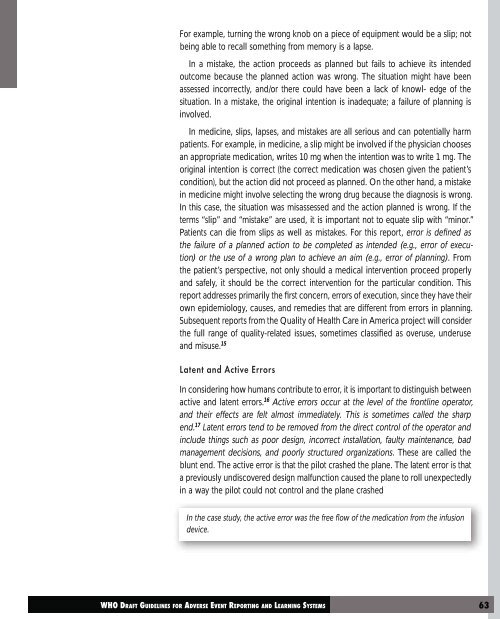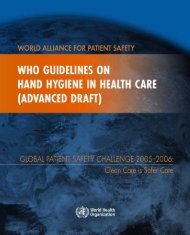Adverse event reporting.pdf
Adverse event reporting.pdf
Adverse event reporting.pdf
Create successful ePaper yourself
Turn your PDF publications into a flip-book with our unique Google optimized e-Paper software.
For example, turning the wrong knob on a piece of equipment would be a slip; not<br />
being able to recall something from memory is a lapse.<br />
In a mistake, the action proceeds as planned but fails to achieve its intended<br />
outcome because the planned action was wrong. The situation might have been<br />
assessed incorrectly, and/or there could have been a lack of knowl- edge of the<br />
situation. In a mistake, the original intention is inadequate; a failure of planning is<br />
involved.<br />
In medicine, slips, lapses, and mistakes are all serious and can potentially harm<br />
patients. For example, in medicine, a slip might be involved if the physician chooses<br />
an appropriate medication, writes 10 mg when the intention was to write 1 mg. The<br />
original intention is correct (the correct medication was chosen given the patient’s<br />
condition), but the action did not proceed as planned. On the other hand, a mistake<br />
in medicine might involve selecting the wrong drug because the diagnosis is wrong.<br />
In this case, the situation was misassessed and the action planned is wrong. If the<br />
terms “slip” and “mistake” are used, it is important not to equate slip with “minor.”<br />
Patients can die from slips as well as mistakes. For this report, error is defined as<br />
the failure of a planned action to be completed as intended (e.g., error of execution)<br />
or the use of a wrong plan to achieve an aim (e.g., error of planning). From<br />
the patient’s perspective, not only should a medical intervention proceed properly<br />
and safely, it should be the correct intervention for the particular condition. This<br />
report addresses primarily the first concern, errors of execution, since they have their<br />
own epidemiology, causes, and remedies that are different from errors in planning.<br />
Subsequent reports from the Quality of Health Care in America project will consider<br />
the full range of quality-related issues, sometimes classified as overuse, underuse<br />
and misuse. 15<br />
Latent and Active Errors<br />
In considering how humans contribute to error, it is important to distinguish between<br />
active and latent errors. 16 Active errors occur at the level of the frontline operator,<br />
and their effects are felt almost immediately. This is sometimes called the sharp<br />
end. 17 Latent errors tend to be removed from the direct control of the operator and<br />
include things such as poor design, incorrect installation, faulty maintenance, bad<br />
management decisions, and poorly structured organizations. These are called the<br />
blunt end. The active error is that the pilot crashed the plane. The latent error is that<br />
a previously undiscovered design malfunction caused the plane to roll unexpectedly<br />
in a way the pilot could not control and the plane crashed<br />
In the case study, the active error was the free flow of the medication from the infusion<br />
device.
















